Most of us know the original sad story of the Medusa, immortalized by Gericault. There are recurring elements in pop culture that have no qualms of turning impact of powerful visual art narratives into…. Gilligan’s Island?
Satire. Copy Cat art. Does it reinforce the very tendencies that the original version sought to represent which were bundled with other ideas that impacted the entire work? The ready made copies of Medusa do banalize the impact of the message and feed it through a loop which empties it of content, resulting in a shell, in effect a mask. It distances itself from what Levinas called the sense of “hopeless” compassion, the profound empathy that asserts, as a counter-ideology, that we are all equal before misfortune.
Not a misfortune giving access to guilt or maintaining a hierarchy of comparison, but rather a misfortune of something substantially intrinsic to creation or the unfolding of the evolutionary process with all its quirks and mysteries; hopeless being the unavoidable suffering. What inevitably happens in these re-appropriations, hostage taking, is kitschification of art; the post-modern redefinition of the grotesque as the monstrous; the codes and signifiers to use Barthes terminology, dominate, even humiliate, repressing what Gericault’s fertile and complex interpretation of the spiritual within the composition and his efforts to link the work back to the tradition of the Old Masters, back to antiquity, becomes imbued now, with elements of the pathological, apparently within the realm of finance capital as patrons and the advertising industry which tranche aspects of this and disseminate them within the larger mass culture.
These new iterations are more in the Dada zone of a Duchamp where the raft is excrement, the figures are excrement and they are floating in an unflushed toilet, a kind of perverted purgatory. Barthes called these types of photographic arts the “agents of death.”
Joel-Peter Witkin:One hundred and fifty people, including one woman, were herded into the slippery beams. So closely were the people huddled together that it was impossible to move a single step. Mutiny, murder, cannibalism and madness followed. After fifteen days, only fifteen survived.
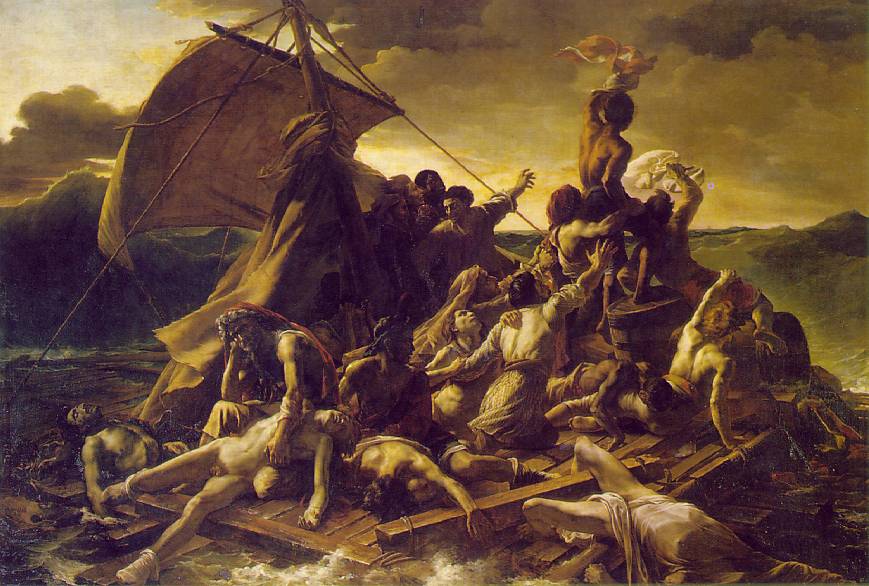
---What I don't know is what happened to him after his lover's sudden death at 33 after falling from his horse. At that point, Daniel disappears from history--in fact, for the many prudish art historians who effaced him, he never belonged there at all. Daniel's most important modeling assignment was in Gericault's The Raft of the Medusa (1819), a famous operatic assemblage of survivors clinging to a tiny ocean raft awaiting rescue. At the apex of a pile of bodies, dead and alive, was Gericault's lover. This shipwreck survivor waves a white cloth torn from a blanket at a tiny ship in the far distance, until their hopes were answered and they were rescued. --- Read More:http://www.associatedcontent.com/article/1013318/gericaults_lover_a_black_male_model.html?cat=37
The people on the Medusa were victims of class struggle. The people on the Raft of George Bush-his party and regime-are the victims of their own rationale, their conservative elitism, their hunger for political and social power and their unilateral military ambitions. It took a very sick group of people to dream up a phony war from the tragedy of 9/11, against a country which had nothing to do with 9/11….

---The Witkin image has been shown at the Galerie Baudoin Lebon in Paris, a city not known for its fondness toward the U.S. president. Parisians do love art history, though, and Wikin’s image is based on one of the touchstones of French art: the 1819 painting “Raft of the Medusa” by Theodore Gericault.--- Read More:http://politicstheoryphotography.blogspot.com/2007/03/joel-peter-witkin-imagines-bushs-ship.html
In my photograph, I want to show the leaders of this regime as royalty without clothes. As the fools they really are.
The president is seen wearing a McDonalds gold paper crown. His despair is the result of a mind distorted by extremism. By the lies, torture, pain and death he has caused. He is the Lear of all inept politicians. He holds the naked body of “Condi Rice”. She is his ideal black woman. His brain-dead muse. Secretary of Defense “Rummy” lies face down nearby, holding his glasses, wrapped in a flag of the nation. Former Secretary of State Powell is pictured dressed only in military epaulets holding the “proof” he presented at the United Nations for justification for the war against Iraq. The vice-president and his wife are shown as an operatic star and diva straining to proselytize their doctrines in song. Barbara Bush is tied to a mast. She holds a sun-reflector under her chin-representing her joy in basking in the sunlight of power yet always looking like “The Quaker Oats Man”. Near her is a conservative minister trying to hang himself while a sailor performs fellatio on him. Finally, an African American waves the flag of his mother country as he sights the Medusa’s survivors, a Chinese junk and a Space Ship. Read More:tp://www.edelmangallery.com/witkin33.htm">http://www.edelmangallery.com/witkin33.htm
ADDENDUM:
In 1816, a convoy of ships led by Hugo de Chaumareys set sail with the goal of reclaiming a colonized Senegal from the English. The captain was old and incapable of navigating the treacherous coastal waters, given that he had not been in command of a ship for more than twenty years; moreover, he arrogantly refused to take the advice of far more able officers. When the Medusa sank, Chaumareys did not go down with his ship: Together with officers and VIPs, he commandeered the lifeboats, and a makeshift raft was constructed for 147 sailors and other passengers. Though the raft was at first towed behind the boats, it was soon set adrift by the captain’s privileged entourage; this group would find its own cruel fate in the Senagalese desert. When the raft was finally found thirteen days later, only fifteen men were still alive: Most had died from exposure or from the anarchic violence that had ensued on board, while the survivors had staved off starvation by resorting to cannibalism. An outraged and highly publicized account written by two of the survivors, geographer Alexandre Corréard and surgeon Jean-Baptiste-Henri Savigny, became a runaway best seller in France and England and rocked the new Bourbon government. Théodore Géricault’s painting of the subject, which won a gold medal at the Salon of 1819, only added fuel to the fire.
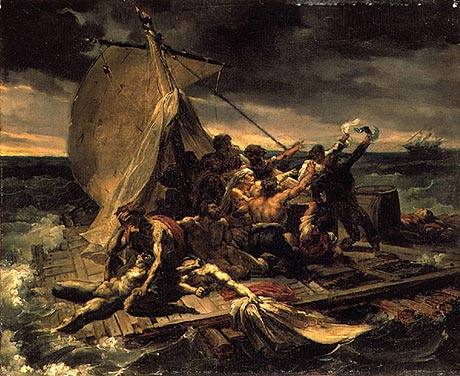
---Gericault, Sketch for the Raft of the Medusa, c. 1818-19--- Read More:http://www.shafe.co.uk/art/Gericault-_Sketch_for_the_Raft_of_the_Medusa-_c-_1818-19.asp
This history is familiar to art historians, and beyond Corréard and Savigny’s account, Miles relies most heavily on art-historical literature to flesh out the details. Despite this, his treatment of Géricault’s iconic image is lacking. The book opens with Corréard arriving in the artist’s studio to advise him on the painting, and indeed Miles imagines that Géricault was a mere mouthpiece for Corréard’s antigovernment and antislavery politics. The inclusion of Corréard’s likeness in The Raft of the Medusa is treated not simply as a matter of historical accuracy; rather, the survivor’s gesture toward the African figure sitting atop a pyramidal arrangement of bodies, desperately signaling a rescue ship on the horizon, “[confirms] the selection and positioning of the figure, as if [Corréard] himself had something to do with the decision to show a black optimistically heralding a new dawn.” …
…And even as Miles imagines Corréard directing the content and form of Géricault’s painting, he is unwilling to see Corréard and Savigny’s description of events as another form of representation, as an attempt by the two men to justify their actions on board the raft in the face of assertions that they had ordered the culling of victims to ensure their own survival. Corréard, in his claim to speak truth to power, wanted to be a hero, and Miles wants to turn him into one. But if we have learned anything in the past years, it’s that we don’t need another hero—we need history. Read More:http://www.bookforum.com/inprint/014_03/865a
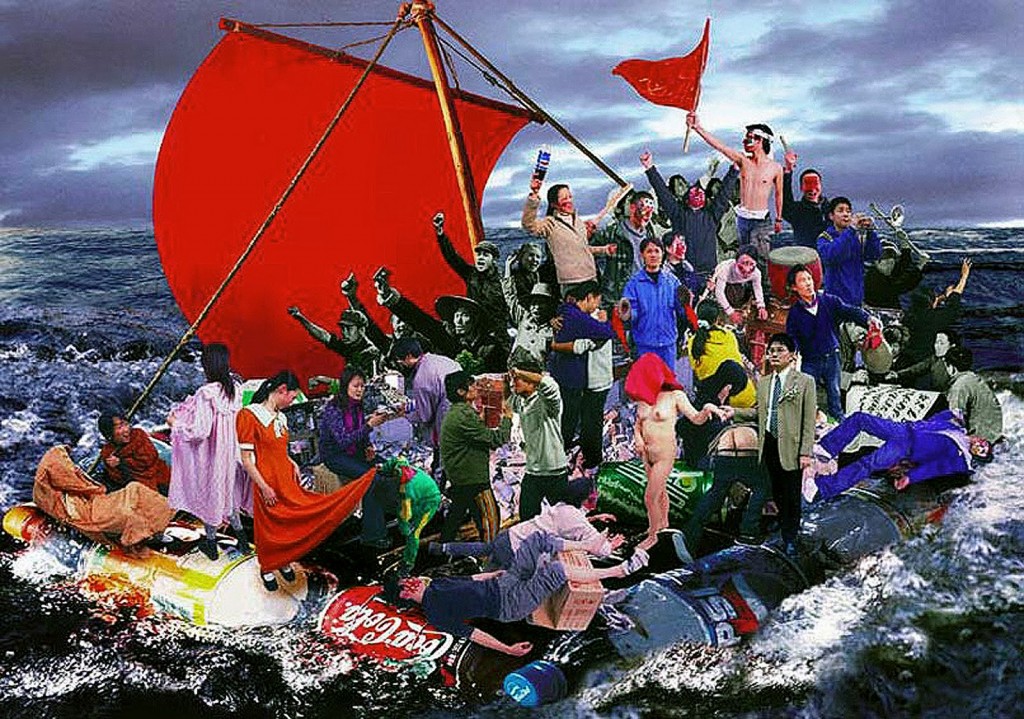
---The painting very elegantly undermines the traditional heroic 19th century historical painting, and, instead, conveys a society in sinking collapse. Hu Jieming parallels this historic occurrence to the regime of the Cultural Revolution with all its sinister cruelty. His Raft of the Medusa, thus, is more than just a reference to the past: The photos are composed of today's excessive amount of consumer goods and advertisement imagery. Additionally, Hu Jieming juxtaposes pictures of today's youth in gestures of self-indulgent hedonism with monochrome grey pictures of the suppressed people in traditional mao-uniforms.--- Read More:http://folksonomy.co/?keyword=10436
——————————————-
Witken: “I seem to incorporate these tendencies, but my initial interest has always been to show the lostness within us. I am an aesthetic priest.” By means of a seemingly deliberate reformulation of Arbus’s famous statement “My favorite thing is to go where I’ve never been,” Witkin has expressed his own otherworldly concerns: “My life wish is to be connected with a place we can’t know, hope to go, or hope to be.” Witkin does claim an affinity with the sensibility of Weegee, whom he considers to be a man of “sadistic benevolence, driven from paradise, like me.” In technique and subject matter, however, Witkin takes measures well beyond photojournalism as Weegee and others have practiced it.Read More:http://www.ohiostatepress.org/books/Book%20PDFs/Goodwin%20Modern.pdf
…Early in his career, Witkin had the following realization: “To me people were only masks. My interests would not be to reveal what the individual subject chose to hide, but instead to make the qualities of the hidden more meaningful. This is why I could engage the world on my own terms. I could deal with people by superimposing my own mask on theirs. . . . My work would have the impact of my irreality.” ( ibid. )


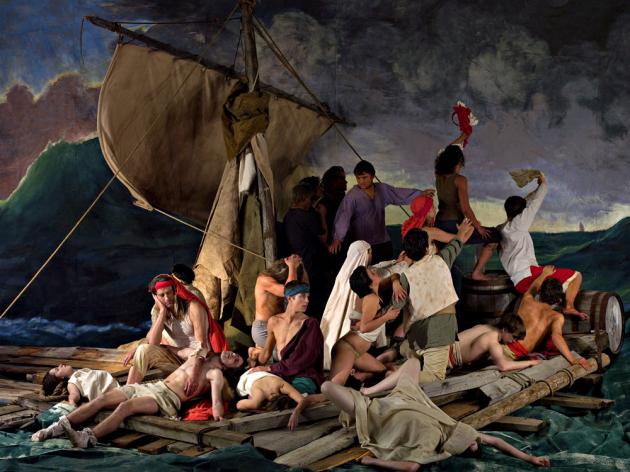
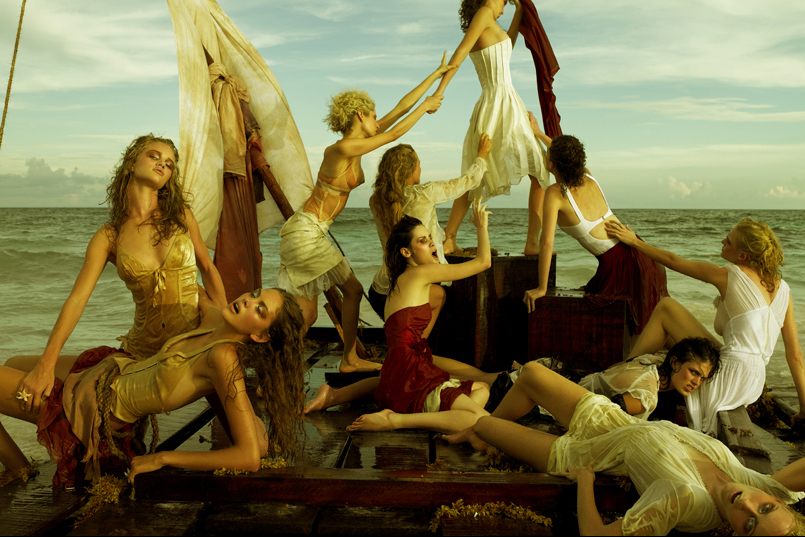



 COMMENTS
COMMENTS